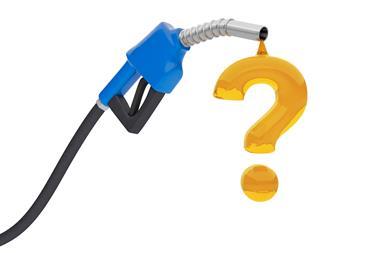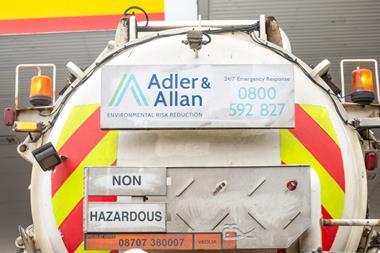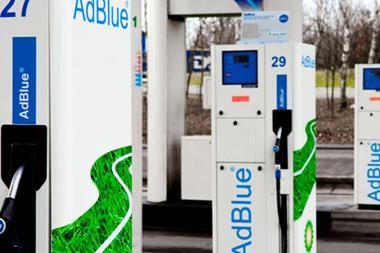Let’s face it, filling up the car with fuel isn’t the most captivating of activities. As well as being tormented by prices that make you wonder if one day you may have to sell a kidney to keep a car on the road, the most exciting thing likely to happen at the pump is landing on a round-pound number dead-on, first time, without irritatingly going a penny over.
But in an age where the media bombards us at every turn, why shouldn’t forecourts be more entertaining places to fill up? In the US, fuel pump television network Outcast has just announced it will display film ratings from mobile movie app Flixster. The information will be shown on more than 13,000 screens across the States, including top-of-the-line gas pumps from Outcast’s partner Gilbarco Veeder-Root, treating motorists to an entertaining few minutes of movie reviews while they fill up, helping to take their minds off their spiralling fuel bill.
Here in the UK, investment in multimedia screens at the pump has been slow to get going, but retailers who have taken the plunge are reaping the benefits. Ed Seaton, who runs BP and Budgens-branded White Post Filling Station in Yeovil, Somerset, has been operating Scheidt & Bachmann’s Clou pumps with multimedia screens since September 2010 when he redeveloped the site. He promotes BP Ultimate premium fuel, Budgens’ three-weekly promotions and the car wash menu, and says motorists enjoy the entertainment.
"Filling up is a more enjoyable experience," says Ed. "When customers fill up it’s impossible not to look at what’s on the screen they are more likely to watch the promotions than watch the pounds going up. It’s well enjoyed by customers and has an added benefit of keeping the forecourt clean and tidy because you don’t need signs all over the place. I can’t think of a better way to get my messages across. I love it."
While Ed says it’s frustratingly impossible to quantify what impact the screens have had on sales, since he’s been promoting a free top car wash with 50 litres of BP Ultimate, sales of the premium fuel have gone up by 25%, and he is positive the pumps are well worth the investment.
Ian Jaques, managing director of Scheidt & Bachmann (S&B) UK, says more retailers are realising the benefits a multimedia screen can bring.
"Investment in pumps used to be a ’commodity’ decision, however, discerning retailers appreciate that this decision will now shape many aspects of their retail strategy, specifically multimedia at the pump," he says. "S&B has proved that multimedia significantly drives retail sales in store. As technology has become more sophisticated, it allows the customer to interact at the pump via the touch-screen interface, which enables retailers to incentivise the customer to shop in store and increase loyalty. This is achieved by allowing them to select promotions where they identify the value, and this is also proven even when the customer has selected to pay at the pump, dispelling the myth that pay-at-pump suppresses shop sales. In fact it provides convenience with reward." Adrian Beeby, national sales manager at Tokheim, says that dispenser technology is also heading towards making the fuelling experience faster, cleaner and easier to manage, and is trying to turn filling up with fuel from a grudge purchase to something that is a more neutral experience. "To this end you will start to see an increase in media on sites and there are a number of new integrated solutions entering the marketplace one of those being Tokheim’s T-Media platform," he says.
T-Media provides a full media package. As it’s web-based, no software needs to be installed locally on the site, and the T-Media hardware calls the web service at pre-determined times using a secure application. "Retailers will often need to give access to different users of the system," says Beeby.
"As an independent or major oil company they may want graphic designers or station managers to upload content. Oil companies may want media providers, ad agencies or marketing personnel across several locations to manage their screens. Customers can assign different access levels quickly with an easy-to-use admin tool set.
"T-Media is programmed to be event driven, meaning that retailers can deliver a variety of messages via sophisticated marketing methods," adds Beeby. "Media can be driven by default standard events such as Idle, Fuelling, or End of Fuelling. T-Media goes one step further by allowing marketers to promote products based on a variety of events such as fuel type, loyalty cards, registration plates (ANPR), timed promotions, closed notices, out of order signs etc."
Matt Clayton, UK sales director at Gilbarco Veeder-Root, also believes that the biggest change at the pump in the near future will be the growth of multimedia on the forecourt. He says that retailers recognise that advertising to a captive audience for two minutes during refuelling, just before a shop purchase, is very effective in increasing shop revenue. "With retailers looking for opportunities to increase in-store sales as they are typically higher margin products multimedia is the perfect tool to address this opportunity," he says.
Gilbarco Veeder-Root has released a fully integrated multimedia dispenser meaning that both transactional and media functionality is displayed within one 15-inch screen. The solution is available on its SK700-II dispenser. "There are a number of benefits to the forecourt retailer," says Clayton.
"Multimedia allows retailers to upsell higher margin products; it builds brand loyalty with customers, which in turn increases the site throughput; and it creates a more modern, dynamic forecourt image."
The content can be managed using a USB or ethernet connection on-site by the forecourt operator or via a network. The solution is said to be completely flexible and can be easily retrofitted on the current range of SK700-II.
Outdoor payment
According to independent market intelligence company Verdict, which is part of the Datamonitor group, a decline in petrol and diesel sales coupled with the desire to reduce costs is forcing Europe’s fuel retailers to convert service stations to unmanned sites.
By 2013, it reckons one in 10 service stations across Europe won’t have any staff at the forecourt leaving motorists to pay for their fuel using automated payment technology.
The research reveals that while Europe’s network of manned service stations has contracted by 3% or 3,622 stations since 2008, the number of unmanned stations has increased by almost 5%. And the trend is set to continue with Verdict predicting the network of fully automated forecourts to increase by 3.7% by 2013.
Wensleydale Garage in the rural town of Masham, North Yorkshire, is one retailer that is making the most out of the ability to be unmanned. While the site has not gone fully unmanned, owner Brian Metcalfe has introduced HTEC’s Hydra POD outdoor payment terminal to offer extended hours of service to the local community, as well as freeing up a bit of time for himself. The unit is on from 6am to 10pm every day and operates all the pumps on the forecourt.
"As a small business we already work very long hours and with the national minimum wage going up, paying additional staff to work evening shifts is not a viable option," says Brian. "The main reason I put it in was so I could free up more time for myself. I find it very beneficial and it’s helped fuel volumes, too. Everyone’s volume has dropped, but ours has picked up a bit. I’m in a rural area and we’re the only filling station, so we can keep serving the community even when we’re closed."
S&B’s Ian Jaques agrees that the UK network is likely to move more into unmanned over the next 10 years, with more supermarkets triggering the process. "Supermarkets will go more unmanned to reduce their costs, and that will drive the rest of the market," he says. "The forecourt market is changing and in the future there are going to be sites where you will have a fuel retailer who will provide the forecourt technology, and the shop will be run separately by a convenience retailer so all fuel transactions will be done at the pump. It will appeal to oil companies because it will keep their brand on the forecourt and convenience retailers will still retain their focus point on forecourts."
S&B has been making outdoor payment more accessible by developing cash acceptance for its pumps, and has its first installation of this technology in the pipeline. This means its machines can now accept credit, debit, fuel and loyalty cards along with cash either at the pump or at standalone outdoor payment terminals, removing any barriers to sales for the retailer.
"History tells us that when challenging economic times prevail, the retail industry is the first to be affected, therefore we have been listening to our customers by finding out what is important to them," he says.
"This collaborative approach has told us that cash is still king and we should not be creating barriers to accepting it. With the number of retail sites shrinking year on year, and the demand for fuel undiminished, payment at the pump will drive the industry forwards over the next decade."
Outdoor payment or pay-at-pump adds another level of convenience for the motorist. While some retailers are still concerned that giving customers the ability to pay outside will mean they’re not coming into the store to buy higher-margin products, pump manufacturers and retailers who have adopted the technology disagree. Tokheim’s Adrian Beeby says: "A very busy site with a successful shop can have forecourt congestion, which reduces the opportunity to sell fuel because people are parking at the pump and going into the shop, which keeps the pump occupied. By using technology to complement their business, retailers can reduce congestion to give those customers in a hurry a convenient option, and the retailer can focus on serving those customers who want to spend time in the shop. Fast lanes dedicated to pay-at-pump are also a simple but effective way for busy sites not to have customers driving away because their forecourt is jammed."
Janet Barraclough, group marketing manager at HTEC, agrees: "Growth in vehicle numbers and a decline in service station numbers puts increasing pressure on sites to handle more vehicles and retailers really need to drive down costs, improve efficiency and extend opening hours. Long queues at the pump could soon become the norm and consumers will actively seek out forecourts with shorter queues. By introducing express lanes that only offer pay-at-pump facilities, retailers can cater for splash and dash customers who want to just fill up and go, and that will reduce queues in-store, offering those customers wanting to use the shop more time to browse, which could actually translate into increased non-fuel sales."
Barraclough adds that pay-at-pump is the ultimate drive-off solution, and with a combination of automatic number plate recognition (ANPR) and outdoor payment, drive-offs can be almost eliminated.
"If your site is experiencing drive-offs, consider making the lane most vulnerable a pre-pay-only lane," she advises. "Feasibility studies show that at minimum wage, each customer costs 24p to serve, so give your shop customers a better service, reduce those queues, extend your opening hours and prevent drive-offs."
The take-up of pay-at-pump varies hugely across the forecourt network, and Jon Dunman, vice president of Torex Convenience Fuel Solutions, says independent retailers have been slow to embrace outdoor payment technology, partly because of the difficulty connecting pumps, point of sale and outdoor payment terminal if they’re all supplied by different manufacturers. However, the Torex OPT server can now answer that problem. "OPT Service sits in the background and can talk between different devices," says Dunman.
"The Torex system pulls the pumps, point of sale and OPT together, making outdoor payment on a dealer forecourt more of a possibility."
Torex also offers a standalone OPT unit that can operate all pumps on the forecourt, and Mike Garner, who runs four sites in Hampshire, is trialling the product at his Jet-branded service station in Borden. "Some customers like to be able to drive in and fill up without entering the shop so we are testing the Torex OPT on one double-sided pump," says Mike. "It’s a very clever piece of equipment capable of running multiple pumps. It’s simple to use customers just follow the instructions on the screen. It has confused some motorists, though, so we are in the process of having the unit modified to make it even easier to operate."
Mike says about 2-3% of his customers just wanted to fill up and go but he’s also noticing that some motorists are using the machine and still going into the store. "I didn’t know what to expect when we installed the machine I had a pretty open mind," he says. "It adds another string to our bow, giving us an edge over the local competition. We have a Tesco, Sainsbury and Esso site with outdoor payment within a 10-mile radius so customers are familiar with paying at the pump. It also gives us the option of going unmanned and opening 24 hours. For some sites it’s not worth paying a member of staff to stay open."
Minimising losses
As fuel margins continue to contract, minimising fuel losses is ever more important. As such, Soren Powell-Holse, sales manager UK and Eire at Wayne, says the company is seeing increased interest from retailers in fuel metering with automatic temperature compensation (ATC). "Driving down wet-stock losses is essential if the retailer is on Standard Temperature Accounting (STA) supply contract with the oil company," he says.
"With fuel being a very valuable commodity, it is even more important that retailers invest in equipment with technology that helps maximise fuel margins. Wayne was early to offer increased meter accuracy with our Xflo meter as well as ATC to ensure that the amount of energy sold/metered out is not unfairly affected by fuel temperature. Our range of pumps and dispensers is popular for many reasons including solid construction and clean lines but, most importantly, for the money saving technologies including low-drift meters like Ecometer and STA with ATC."
Tokheim has also developed its metering technology. Adrian Beeby says: "Tokheim’s Quality Meter is being rolled out across the UK with the highest accuracy ever seen in the industry and faster fuel throughput.
Standard Temperature Accounting (STA) has been really successful and is a fully approved technology that allows for fuel to be dispensed at 15°C. It means even a small site could save up to 15,000 litres of fuel a year a huge saving for any business."
Security has become another focus for Wayne in a bid to help retailers minimise losses. "With fuel prices continuing to rise, retailers have seen a rise in theft and fraud, which makes it more important for retailers to protect their stock and prevent attempted fraud," says Powell-Holse.
"Wayne has developed several security options, which have been adopted well in other European markets that saw this unfortunate trend before the UK."
The new security options include shell protection that prevents unauthorised access to the dispenser.
Finally, proper maintenance of your investment is just as important as the technology itself, and Wayne advises retailers to take a more proactive approach to maintenance. Says Powell-Holse: "Most of us service our cars regularly to extend life and maintain value, and Wayne offers the same to our retailers with our Planned Preventative Maintenance. It’s all about ensuring nozzle availability, to ensure the retailer can serve his customers when they visit his forecourt. There is plenty of competition these days, so don’t give your customers a bad experience and lose them due to lack of maintenance."
TOP TIPS
Clean the dispensers regularly using non-aggressive products and definitely not a jet washer.
Report any issues to your maintenance company as soon as they occur.
Undertake regular preventative maintenance to avoid expensive downtime.
What to look for in a service provider:
Ensure your maintenance service provider has full industry health and safety accreditation.
Look for technical competence and industry expertise across the forecourt.
A parts supply and logistics system that enables your service provider to have the right part at the right time to keep you operating.
Can the provider respond quickly and when you need them are their engineers located close to your operations?
Source: Gilbarco Veeder-Root





























No comments yet